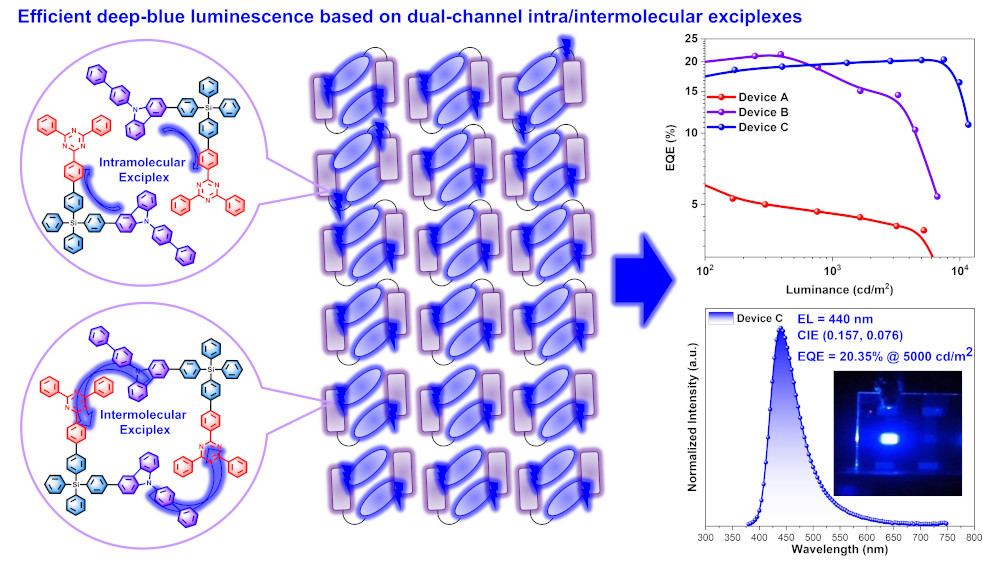
13 Jun OLEDs: deep blue, efficient and durable
Organic light-emitting diodes (OLEDs) are energy-efficient and flexible in application. But one challenge is the production of blue OLEDs – these have so far lacked luminance and stability. Researchers at the Karlsruhe Institute of Technology (KIT) and Shanghai University have now developed a new strategy for producing efficient deep blue OLEDs.
OLEDs are already used in many smartphones, tablets, and large-screen televisions. They do not require additional backlighting and are therefore energy-efficient, can be manufactured inexpensively using thin-film technology, and also function on flexible substrate materials, enabling flexible displays and variable room lighting solutions.
Glow in thin layers
An OLED consists of two electrodes, at least one of which is transparent. Between them are thin layers of organic semiconducting materials. The glow is electroluminescence: when an electric field is applied, electrons from the cathode and holes from the anode are injected into the organic materials serving as emitters. The electron-hole pairs that are formed in these layers subsequently decay to their initial state, releasing energy in the form of light. All color shades are produced by mixing the three colors blue, green and red.
Why the color blue causes difficulties
So far, only the colors red and green are available for commercial applications as phosphorescent OLEDs. The color blue is available as fluorescent OLEDs, which only glow for a short time. With blue OLEDs, it is difficult to reconcile high efficiency, high luminescence and long lifetime – the blue pixels glow more weakly or fade faster than the green and red pixels.
A luminescent molecular complex
The researchers now made a novel molecule consisting of carbazole and triazine fragments linked by a silicon atom (CzSiTrz). When the molecules assemble into nanoparticles, electronic excitation results in intramolecular charge transfer emission and intermolecular exciplex luminescence. An exciplex is an electronically excited molecular complex; its emission is different from the emissions of the excited individual molecules. “With the exciplex strategy, deep blue electroluminescence can be achieved because the energy levels of the electron-donating carbazole fragments and the electron-accepting triazine fragments can be set independently of each other,” explains Professor Stefan Bräse, researcher at the KIT.

Emission within and between molecules makes deep blue OLEDs shine efficiently and steadily. Image: Zhen Zhang
For example, the team succeeded in creating deep blue OLEDs with a record-breaking external quantum efficiency of 20.35 %. In addition, these OLEDs achieve a high luminance of 5,000 candela per square meter (cd/m2). The perceptible blue has coordinates of 0.157/0.076 on the International Commission on Illumination (CIE) chromaticity diagram. Bräse is convinced, “The easy synthesis of the molecule and the simple fabrication of the devices pave the way for a new generation of efficient and long-lasting deep blue OLEDs.” The research was carried out at the Institute of Organic Chemistry (IOC) and the Institute of Biological and Chemical Systems – Functional Molecular Systems (IBCS-FMS) of KIT together with scientists at Shanghai University.
Original publication
[Zhen Zhang, Dehai Dou, Rongrong Xia, Peng Wu, Eduard Spuling, Ke Wang, Jin Cao, Bin Wei, Xifeng Li, Jianhua Zhang, Stefan Bräse, and Zixing Wang: Efficient deep-blue luminescence based on dual-channel intra/intermolecular exciplexes. Science Advances, 2023. DOI: 10.1126/sciadv.adf4060]
Source: www.kit.edu
Image: Markus Breig, KIT






